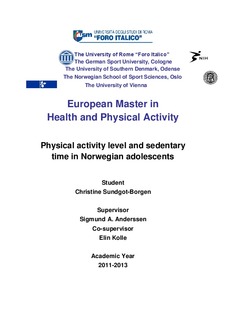| dc.description.abstract | Background: Physical activity (PA) is necessary for children and adolescents to
obtain a healthy development. The environment, however, facilitates the sedentary
lifestyle. World health organization (WHO) defines physical inactivity as the
fourth major risk factor for mortality. Still, adolescents in Europe and America are
sedentary more than 50 % of their waking hours. Lack of comparability between
studies investigating PA level and sedentary time in adolescents creates need for
further documentation. Objective: The objective was to investigate PA level and
sedentary time in Norwegian 15-year olds. In addition, I wanted to study whether
sedentary time and moderate-to-vigorous PA (MVPA) were associated with waist
circumference (WC) and body mass index (BMI). Method: Data was drawn from
the cross-sectional part of the PANCS2 (2011). A total of 1046 15-year-old boys
and girls were included to represent the Norwegian adolescent population. PA and
sedentary time were assessed objectively by ActiGraph accelerometers.
Measurements of BMI (in kg/m2) and WC were taken by trained investigators.
The International Obesity Task Force cut-offs were used to define overweight and
obese subjects. Analyzes conducted were independent and dependent t-test, Chisquare
test, Pearson’s correlation, univariat, and multivariate regression. Results:
The adolescents had a mean (SD) PA level of 456 (160) counts per minute. The
mean PA level was higher during the week compared to the weekend. The
recommendations of 60 minutes of MVPA were reached by 50.7 %. Boys were
significantly more active than girls. The participants spent 71 % of the measured
time being sedentary, and girls were more sedentary than boys. Sedentary time
was not associated with either WC or BMI, while MVPA was associated with
both variables. Conclusion: The adolescent’s PA level is not favorable, and the
2
amount of time spent sedentary is concerning. There is a difference in PA level
between week and weekend, and between the sexes. Sedentary time was not
associated with WC or BMI, while MVPA was associated with both variables. | no_NO |
